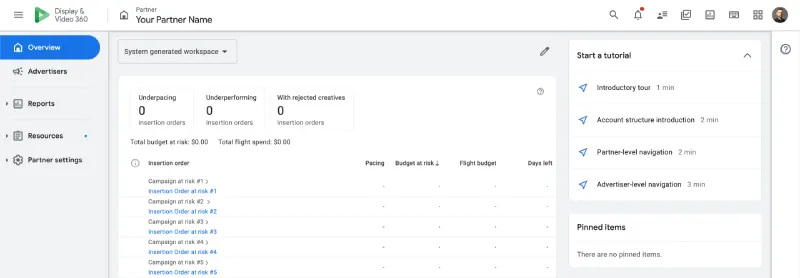July 5, 2024
by Bartosz Salamon
Share
Programmatic advertising has revolutionized the way digital ads are bought and sold, making the process more efficient, targeted, and data-driven. It automates the buying of ad space in real time, allowing marketers to reach their desired audience more effectively. One of the leading platforms in this space is Display & Video 360 (DV360), part of the Google Marketing Platform. DV360 offers a suite of tools for managing programmatic campaigns, making it an essential tool for modern marketers.

What is DV360?
Display & Video 360 (DV360) is a demand-side platform (DSP) that enables marketers to plan, execute, and optimize their digital advertising campaigns across various channels, including display, video, audio, TV, and mobile. Owned by Google, DV360 integrates seamlessly with other Google Marketing Platform products, providing a unified solution for programmatic advertising.
DV360 emerged from the rebranding of DoubleClick Bid Manager (DBM) as part of Google’s effort to streamline its advertising solutions under the Google Marketing Platform umbrella. This integration allows marketers to access advanced features and data insights, enhancing their ability to deliver highly targeted and effective ad campaigns.
With DV360, marketers can manage their campaigns from a single interface, taking advantage of features such as comprehensive campaign management, precise audience targeting, creative optimization, and detailed reporting. The platform’s capabilities make it a preferred choice for advertisers looking to maximize their programmatic advertising efforts.

Key Features of DV360
DV360 offers a range of features designed to help marketers achieve their advertising goals efficiently. It is Google-owned platform which allows to use almost whole inventory of technology gigant and data insights provided from their apps and search results.
Comprehensive Campaign Management
- Plan and execute campaigns across multiple channels, including display, video, audio.
- Keep frequency on whole campaign and all types of formats, not only specific creatives.
- Manage all aspects of a campaign, from creative development to media buying and performance analysis in one environment.
Audience Targeting
- Leverage Google’s data ecosystem to target specific audience segments based on their intents, interests and demographic.
- Use first-party data with audiences created as tag-based or within customer match feature to reach the most relevant for you audiences.
- Google scrapers are constantly searching web for new content and reporting it with a specific category. As that being said contextual targeting in DV360 is quite powerful and is part of main targeting-approach.
Creative Optimization
- Create and test multiple ad creatives to determine which performs best.
- Utilize dynamic creative optimization to personalize ads based on user behavior and context.
- Use triggers available in AdsLinkers platform such as weather, forex exchange, TV sync to adjust creatives in your campaigns.

Integration Possibilities
DV360 seamlessly integrates with other Google Marketing Platform products, such as Google Ads, Google Analytics, Firebase and YouTube. This integration allows for unified campaign management and enhanced data sharing.
Benefits of Using DV360
DV360 provides several advantages that can significantly enhance your programmatic advertising efforts. One of the primary benefits is its extensive reach. By accessing an inventory of ad placements across the web (not only Google Ad Manager but other exchanges as well), including premium publishers and high-traffic sites, DV360 allows marketers to extend their reach through cross-channel campaigns that encompass display, video, TV, and mobile. This broader reach is complemented by precision targeting capabilities. Leveraging Google’s data ecosystem, marketers can target specific audience segments with great accuracy using first-party data, third-party data, and Google Audience data. This ensures that ads are served to the most relevant audiences, increasing the likelihood of engagement and conversion.
Close to real-time optimization is another key benefit of DV360. The platform’s machine learning algorithms and performance data allow for continuous optimization of campaigns. Marketers can adjust bids, creatives, and targeting settings on the fly to improve campaign outcomes, ensuring that ad spend is used efficiently. Additionally, DV360’s comprehensive reporting tools provide deep insights into campaign performance. Marketers can access detailed reports and dashboards that offer valuable data on key metrics such as impressions, clicks, conversions. This data-driven approach enables marketers to refine their strategies and make informed decisions to enhance future campaigns.
Best Practice While Working in DV360
As a programmatic expert with years of experience in DV360, there are crucial best practices that can help you get the most out of Display & Video 360. Firstly, it’s essential to manage your budgets and flight dates carefully to ensure your campaigns run smoothly and effectively. Consistent A/B testing of campaign settings, creatives, and optimization methods is vital, as is making experimentation a constant part of your strategy. Testing different audience segments allows you to identify and target the most responsive groups.
Analyzing your data regularly helps you make informed decisions and refine your strategies. It’s also important to choose the correct goals for your advertising efforts to ensure alignment with your overall marketing objectives. Maintaining appropriate frequency caps for your entire campaign, as well as for specific insertion orders and line items, helps prevent ad fatigue and maximizes reach. Personalized creatives are more engaging, and the AdsLinkers platform can automate your advertising to align with triggers surrounding your customers, ensuring relevance.
Remarketing is another key practice, allowing you to re-engage your most engaged users and drive further conversions. Analyzing inventory ensures that your ads are displayed in the best possible contexts. Finally, maintaining strict brand safety measures by using inclusion lists and excluding certain keywords is crucial to protecting your brand’s reputation. By following these best practices, you can optimize your DV360 campaigns for maximum impact and efficiency.
Case Study: Weather-Based Advertising in DV360
Challenge
A major media agency in Central and Eastern Europe (CEE) faced a challenge with a fashion retailer client. The retailer’s big portfolio included products whose demand was highly dependent on weather conditions. Light summer dresses sold well in sunny weather, while raincoats and boots were in demand during rain. The multi-location campaigns couldn’t respond quickly to changing weather conditions, leading to inefficient ad spend.
Approach
AdsLinkers automated the client’s DV360 programmatic ads, adjusting campaigns based on real-time weather conditions. Automated triggers were set to run ads for rain gear during precipitation and to pause them in sunny weather. This dynamic system broadcast relevant ads across Poland using five different weather scenarios.
Results
- Increased Relevance: Ads were displayed only under relevant weather conditions, enhancing engagement.
- Optimized Ad Spend: Reduced waste by showing ads only when they matched the weather.
- Improved Sales: Higher conversions as ads aligned with immediate consumer needs.
- Enhanced Efficiency: Freed up the support team from manual adjustments.

Contact us to automate you marketing campaigns!
Are you ready to elevate your programmatic advertising strategy with DV360? Contact AdsLinkers today to learn how our advanced platform can help you harness the power of DV360 to maximize your campaign performance. Don’t miss out on the opportunity to make your advertising more relevant, efficient, and effective. Schedule a demo now and see the difference firsthand!







